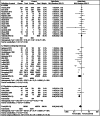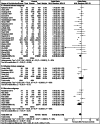Helicobacter pylori infection is associated with reduced risk of Barrett's esophagus: a meta-analysis and systematic review
- PMID: 34876031
- PMCID: PMC8650239
- DOI: 10.1186/s12876-021-02036-5
Helicobacter pylori infection is associated with reduced risk of Barrett's esophagus: a meta-analysis and systematic review
Abstract
Background: Helicobacter pylori (Hp) is a class I carcinogen in gastric carcinogenesis, but its role in Barrett's esophagus (BE) is unknown. Therefore, we aimed to explore the possible relationship.
Methods: We reviewed observational studies published in English until October 2019. Summary odds ratios (ORs) and 95% confidence intervals (CIs) were calculated for included studies.
Results: 46 studies from 1505 potential citations were eligible for inclusion. A significant inverse relationship with considerable heterogeneity was found between Hp (OR = 0.70; 95% CI, 0.51-0.96; P = 0.03) and BE, especially the CagA-positive Hp strain (OR = 0.28; 95% CI, 0.15-0.54; P = 0.0002). However, Hp infection prevalence was not significantly different between patients with BE and the gastroesophageal reflux disease (GERD) control (OR = 0.99; 95% CI, 0.82-1.19; P = 0.92). Hp was negatively correlated with long-segment BE (OR = 0.47; 95% CI, 0.25-0.90; P = 0.02) and associated with a reduced risk of dysplasia. However, Hp had no correlated with short-segment BE (OR = 1.11; 95% CI, 0.78-1.56; P = 0.57). In the present infected subgroup, Hp infection prevalence in BE was significantly lower than that in controls (OR = 0.69; 95% CI, 0.54-0.89; P = 0.005); however, this disappeared in the infection history subgroup (OR = 0.88; 95% CI, 0.43-1.78; P = 0.73).
Conclusions: Hp, especially the CagA-positive Hp strain, and BE are inversely related with considerable heterogeneity, which is likely mediated by a decrease in GERD prevalence, although this is not observed in the absence of current Hp infection.
Keywords: Barrett’s esophagus; Gastroesophageal reflux disease; Helicobacter pylori.
© 2021. The Author(s).
Conflict of interest statement
The authors declare that they have no competing interests.
Figures






Similar articles
-
Association between Helicobacter pylori and Barrett's esophagus, erosive esophagitis, and gastroesophageal reflux symptoms.Clin Gastroenterol Hepatol. 2014 Feb;12(2):239-45. doi: 10.1016/j.cgh.2013.08.029. Epub 2013 Aug 27. Clin Gastroenterol Hepatol. 2014. PMID: 23988686 Free PMC article.
-
Helicobacter pylori Infection Is Associated With Reduced Risk of Barrett's Esophagus: An Analysis of the Barrett's and Esophageal Adenocarcinoma Consortium.Am J Gastroenterol. 2018 Aug;113(8):1148-1155. doi: 10.1038/s41395-018-0070-3. Epub 2018 Jun 8. Am J Gastroenterol. 2018. PMID: 29880962
-
CagA-positive strains of Helicobacter pylori may protect against Barrett's esophagus.Am J Gastroenterol. 2000 Sep;95(9):2206-11. doi: 10.1111/j.1572-0241.2000.02305.x. Am J Gastroenterol. 2000. PMID: 11007219
-
Effect of Helicobacter pylori infection in Barrett's esophagus and the genesis of esophageal adenocarcinoma.World J Surg. 2003 Sep;27(9):994-8. doi: 10.1007/s00268-003-7051-3. Epub 2003 Jul 24. World J Surg. 2003. PMID: 14560364 Review.
-
Prevalence of Helicobacter pylori infection in 160 patients with Barrett's oesophagus or Barrett's adenocarcinoma.Aust N Z J Surg. 2000 Jan;70(1):26-33. doi: 10.1046/j.1440-1622.2000.01737.x. Aust N Z J Surg. 2000. PMID: 10696939 Review.
Cited by
-
Community assembly modeling of microbial evolution within Barrett's esophagus and esophageal adenocarcinoma.bioRxiv [Preprint]. 2025 Jan 16:2025.01.14.633020. doi: 10.1101/2025.01.14.633020. bioRxiv. 2025. PMID: 39868296 Free PMC article. Preprint.
-
Helicobacter pylori in children: think before you kill the bug!Therap Adv Gastroenterol. 2023 Jun 15;16:17562848231177610. doi: 10.1177/17562848231177610. eCollection 2023. Therap Adv Gastroenterol. 2023. PMID: 37361453 Free PMC article. Review.
-
Current Status and Future Prospects for Esophageal Cancer.Cancers (Basel). 2023 Jan 26;15(3):765. doi: 10.3390/cancers15030765. Cancers (Basel). 2023. PMID: 36765722 Free PMC article. Review.
-
The Role of Microbiota in Upper Gastrointestinal Cancers.Cancers (Basel). 2025 May 21;17(10):1719. doi: 10.3390/cancers17101719. Cancers (Basel). 2025. PMID: 40427216 Free PMC article. Review.
-
Efficacy of Pyloshot in combination with standard four-drug antimicrobial treatment for Helicobacter pylori eradication: A randomized clinical trial.JGH Open. 2024 Dec 8;8(12):e70046. doi: 10.1002/jgh3.70046. eCollection 2024 Dec. JGH Open. 2024. PMID: 39655241 Free PMC article.
References
-
- Hooi JKY, Lai WY, Ng WK, Suen MMY, Underwood FE, Tanyingoh D, Malfertheiner P, Graham DY, Wong VWS, Wu JCY, et al. Global prevalence of Helicobacter pylori infection: systematic review and meta-analysis. Gastroenterology. 2017;153(2):420–429. - PubMed
-
- Edgren G, Adami HO, Weiderpass E, Nyren O. A global assessment of the oesophageal adenocarcinoma epidemic. Gut. 2013;62(10):1406–1414. - PubMed
-
- Sharma P. Clinical practice. Barrett’s esophagus. N Engl J Med. 2009;361(26):2548–2556. - PubMed
Publication types
MeSH terms
LinkOut - more resources
Full Text Sources
Medical
Research Materials
Miscellaneous

